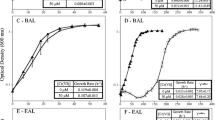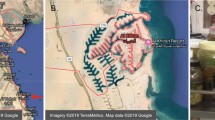Abstract
The interactions between sulfate-reducing microorganisms and iron oxides influence a number of important redox-sensitive biogeochemical processes including the formation of iron sulfides. Enzymes, such as hydrogenase which catalyze the reversible oxidation of molecular hydrogen, are known to mediate electron transfer to metals and may contribute to the formation and speciation of ferrous sulfides formed at the cell–mineral interface. In the present study, we compared the whole cell hydrogenase activity of Desulfovibrio desulfuricans strain Essex 6 growing as biofilms on hematite (hematite-associated) or as suspended populations using different metabolic pathways. Hematite-associated cells exhibited significantly greater hydrogenase activity than suspended populations during sulfate respiration but not during pyruvate fermentation. The enhanced activity of the hematite-associated, sulfate-grown cells appears to be dependent on iron availability rather than a general response to surface attachment since the activity of glass-associated cells did not differ from that of suspended populations. Hydrogenase activity of pyruvate-fermenting cells was stimulated by addition of iron as soluble Fe(II)Cl2 and, in the absence of added iron, both sulfate-reducing and pyruvate-fermenting cells displayed similar rates of hydrogenase activity. These data suggest that iron exerts a stronger influence on whole cell hydrogenase activity than either metabolic pathway or mode of growth. The location of hydrogenase to the cell envelope and the enhanced activity at the hematite surface in sulfate-reducing cells may influence the redox conditions that control the species of iron sulfides on the mineral surface.




Similar content being viewed by others
References
Gadd GM (2010) Metals, minerals and microbes: geomicrobiology and bioremediation. Microbiology 156:609–643
Gadd GM (2004) Microbial influence on metal mobility and application for bioremediation. Geoderma 122:109–119
White C, Sayer JA, Gadd GM (1997) Microbial solubilization and immobilization of toxic metals: key biogeochemical processes for treatment of contamination. FEMS Microbiol Rev 20:503–516
Rickard DT, Luther GW III (2007) Chemistry of iron sulfides. Chem Rev 107:514–562
Neal AL, Techkarnjanaruk S, Dohnalkova A, McCready D, Peyton BM, Geesey GG (2001) Iron sulfides and sulfur species produced at hematite surfaces in the presence of sulfate-reducing bacteria. Geochim Cosmochim Acta 65:223–235
Benning LG, Wilkin RT, Konhauser KO (1999) Iron monosulphide stability: Experiments with sulphate-reducing bacteria. In: Armannsson H (ed) Geochemistry of the Earth’s Surface, vol. A. A. Balkema, Rotterdam, pp 429–432
Herbert RB, Benner SG, Pratt AR, Blowes DW (1998) Surface chemistry and morphology of poorly crystalline iron sulfides precipitated in media containing sulfate-reducing bacteria. Chem Geol 144:87–97
Rickard DT (1969) The microbiological formation of iron sulphides
Li Y-L, Vali H, Yang J, Phelps TJ, Zhang CL (2006) Reduction of iron oxides enhanced by a sulfate-reducing bacterium and biogenic H2S. Geomicrobiol J 23:103–117
Simon M (1985) Specific uptake rates of amino acids by attached and free-living bacteria in a mesotrophic lake. Appl Environ Microbiol 49:1254–1259
Grossart HP, Tang KW, Kiørboe T, Ploug H (2007) Comparison of cell-specific activity between free-living and attached bacteria using isolates and natural assemblages. FEMS Microbiol Lett 266:194–200
Fletcher M (1986) Measurement of glucose utilization by Pseudomonas fluorescens that are free-living and that are attached to surfaces. Appl Environ Microbiol 52:672–676
Li JH, Purdy KJ, Takii S, Hayashi H (1999) Seasonal changes in ribosomal RNA of sulfate-reducing bacteria and sulfate reducing activity in a freshwater lake sediment. FEMS Microbiol Ecol 28:31–39
Widdel F (1988) Microbiology and ecology of sulfate- and sulfur-reducing bacteria. In: Zehnder A (ed) Biology of Anaerobic Microorganisms. Wiley, New York
Postgate JR (1984) The Sulphate-Reducing Bacteria. Cambridge Press, Cambridge
Casalot L, Valette O, De Luca G, Dermoun Z, Rousset M, de Philip P (2002) Construction and physiological studies of hydrogenase depleted mutants of Desulfovibrio fructosovorans. FEMS Microbiol Lett 214:107–112
Pohorelic BKJ, Voordouw JK, Lojou E, Dolla A, Harder J, Voordouw G (2002) Effects of deletion of genes encoding Fe-only hydrogenase of Desulfovibrio vulgaris Hildenborough on hydrogen and lactate metabolism. J Bacteriol 184:679–686
Van den Berg WA, Van Dongen WM, Veeger C (1991) Reduction of the amount of periplasmic hydrogenase in Desulfovibrio vulgaris (Hildenborough) with antisense RNA: direct evidence for an important role of this hydrogenase in lactate metabolism. J Bacteriol 173:3688–3694
Odom JM, Wall JD (1987) Properties of a hydrogen-inhibited mutant of Desulfovibrio desulfuricans ATCC 27774. J Bacteriol 169:1335–1337
Hatchikian EC, Forget N, Bernadac A, Alazard D, Ollivier B (1995) Involvement of a single periplasmic hydrogenase for both hydrogen uptake and production in some Desulfovibrio species. Res Microbiol 146:129–141
Bryant RD, Kloeke FVO, Laishley EJ (1993) Regulation of the periplasmic [Fe] hydrogenase by ferrous iron in Desulfovibrio vulgaris (Hildenborough). Appl Environ Microbiol 59:491–495
Vignais PM, Billoud B (2007) Occurrence, classification, and biological function of hydrogenases: An overview. Chem Rev 107:4206–4272
De Luca G, de Philip P, Dermoun Z, Rousset M, Vermeglio A (2001) Reduction of technetium(VII) by Desulfovibrio fructosovorans is mediated by the nickel-iron hydrogenase. Appl Environ Microbiol 67:4583–4587
Lovley DR, Roden EE, Phillips EJP, Woodward JC (1993) Enzymatic iron and uranium reduction by sulfate-reducing bacteria. Mar Geol 113:41–53
Chardin B, Giudici-Orticoni M-T, Luca G, Guigliarelli B, Bruschi M (2003) Hydrogenases in sulfate-reducing bacteria function as chromium reductase. Appl Microbiol Biotechnol 63:315–321
Vignais PM, Billoud B, Meyer J (2001) Classification and phylogeny of hydrogenases. FEMS Microbiol Rev 25:455–501
Nivière V, Bernadac A, Forget N, Fernández VM, Hatchikian CE (1991) Localization of hydrogenase in Desulfovibrio gigas cells. Arch Microbiol 155:579–586
Fauque G, Peck HD Jr, Moura JJG, Huynh BH, Berlier Y, DerVartanian DV, Teixeira M, Przybyla AE, Lespinat PA, Moura I, LeGall J (1988) The three classes of hydrogenases from sulfate-reducing bacteria of the genus Desulfovibrio. FEMS Microbiol Rev 54:229–344
Meyer J (2007) [FeFe] hydrogenases and their evolution: a genomic perspective. Cell Mol Life Sci 64:1063–1084
Burlage RS, Atlas R, Stahl D, Geesey G, Sayler G (1998) Techniques in Microbial Ecology. Oxford University Press, New York
Stams AJM, Grolle KCF, Frijters CTM, van Lier J (1992) Enrichment of thermophilic propionate-oxidizing bacteria in syntrophy with Methanobacterium thermoautotrophicum or Methanobacterium thermoformicicum. Appl Environ Microbiol 58:346–352
Cammack R, Fernandez VM, Hatchikian EC (1994) Nickel-iron hydrogenase. Meth Enzymol 243:43–68
Yu L, Wolin MJ (1969) Hydrogenase measurement with photochemically reduced methyl viologen. J Bacteriol 98:51–55
Cypionka H, Dilling W (1986) Intracellular localization of the hydrogenase in Desulfotomaculum orientis. FEMS Microbiol Lett 36:257–260
Stookey LL (1970) Ferrozine-a new spectrophotometric reagent for iron. Anal Chem 42:779–781
Gbur EE, Stroup WW, McCarter KS, Durham S, Young LJ, Christman M, West M, Kramer M (2012) Analysis of Generalized Linear Mixed Models in the Agricultural and Natural Resources Sciences. American Society of Agronomy, Madison
Ausabel FM, Brent R, Kingston RE, Moore DD, Seidman JG, Smith JA, Struhl K (1997) Current protocols in molecular biology. John Wiley and Sons, Inc, New York
Wawer C, Muyzer G (1995) Genetic diversity of Desulfovibrio spp. in environmental samples analyzed by denaturing gradient gel electrophoresis of [NiFe] hydrogenase gene fragments. Appl Environ Microbiol 61:2203–2210
Hatchikian EC, Magro V, Forget N, Nicolet Y, Fontecilla-Camps J (1999) Carboxy-terminal processing of the large subunit of [Fe] hydrogenase from Desulfovibrio desulfuricans ATCC 7757. J Bacteriol 181:2947–2952
Neal AL, Clough LK, Perkins TD, Little BJ, Magnuson TS (2004) In situ measurement of Fe(III) reduction activity of Geobacter pelophilus by simultaneous in situ RT-PCR and XPS analysis. FEMS Microbiol Ecol 49:163–169
Magnuson TS, Neal AL, Geesey GG (2004) Combining in situ reverse transcriptase polymerase chain reaction, optical microscopy, and X-ray photoelectron spectroscopy to investigate mineral surface-associated microbial activities. Microb Ecol 48:578–588
Hall TA (1999) BioEdit: a user-friendly biological sequence alignment editor and analysis program for Windows 95/98/NT. Nucleic Acid S 41:95–98
Wu L-F, Ize B, Chanal A, Quentin Y, Fichant G (2000) Bacterial twin-arginine signal peptide-dependent protein translocation pathway: evolution and mechanism. J Mol Microbiol Biotechn 2:179–189
Steger JL, Vincent C, Ballard JD, Krumholz LR (2002) Desulfovibrio sp. genes involved in the respiration of sulfate during metabolism of hydrogen and lactate. Appl Environ Microbiol 68:1932–1937
van Loosdrecht MC, Lyklema J, Norde W, Zehnder AJ (1990) Influence of interfaces on microbial activity. Microbiol Mol Biol Rev 54:75–87
Odom JM, Peck HD (1981) Hydrogen cycling as a general mechanism for energy coupling in the sulfate-reducing bacteria, Desulfovibrio sp. FEMS Microbiol Lett 12:47–50
Fitz RM, Cypionka H (1989) A study on electron transport-driven proton translocation in Desulfovibrio desulfuricans. Arch Microbiol 152:369–376
Baty AM III, Eastburn CC, Diwu Z, Techkarnjanaruk S, Goodman AE, Geesey GG (2000) Differentiation of chitinase-active and non-chitinase-active subpopulations of a marine bacterium during chitin degradation. Appl Environ Microbiol 66:3566–3573
Meckenstock R, Steinle P, van der Meer JR, Snozzi M (1998) Quantification of bacterial mRNA involved in degradation of 1,2,4-trichlorobenzene by Pseudomonas sp. strain P51 from liquid culture and from river sediment by reverse transcriptase PCR (RT/PCR). FEMS Microbiol Lett 167:123–129
Miskin IP, Farrimond P, Head IM (1999) Identification of novel bacterial lineages as active members of microbial populations in a freshwater sediment using a rapid RNA extraction procedure and RT-PCR. Microbiology 145:1977–1987
Wilson MS, Bakermans C, Madsen EL (1999) In situ, real-time catabolic gene expression: extraction and characterization of naphthalene dioxygenase mRNA transcripts from groundwater. Appl Environ Microbiol 65:80–87
Gramp JP, Bigham JM, Jones FS, Tuovinen OH (2010) Formation of Fe-sulfides in cultures of sulfate-reducing bacteria. J Hazard Mater 175:1062–1067
Jeffrey R, Melchers RE (2003) Bacteriological influence in the development of iron sulphide species in marine immersion environments. Corros Sci 45:693–714
Acknowledgments
The authors would like to thank M. Mazzola and S. L. Strauss for the review of the manuscript and A. Lasher for technical assistance. This work was funded by Inland Northwest Research Alliance grant MSU003.
Author information
Authors and Affiliations
Corresponding author
Rights and permissions
About this article
Cite this article
Reardon, C.L., Magnuson, T.S., Boyd, E.S. et al. Hydrogenase Activity of Mineral-Associated and Suspended Populations of Desulfovibrio desulfuricans Essex 6. Microb Ecol 67, 318–326 (2014). https://doi.org/10.1007/s00248-013-0308-y
Received:
Accepted:
Published:
Issue Date:
DOI: https://doi.org/10.1007/s00248-013-0308-y




